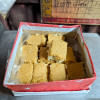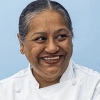The food scene in the city is as diverse as its people and just as expressive. And by expressive, I mean deeply personal. Food here is not just something we eat — it's something we are! In Dhaka, you don't need to scale hills or cross rivers to taste the country's rich regional delicacies. You just need to be hungry. Why? Because, no matter where you are from, there's probably a corner that smells of your childhood.
This is the metropolis's secret superpower. For a city that's relentlessly fast, loud, and crowded enough to make anyone consider monastic life, it has a surprisingly tender culinary soul. It doesn't just feed you — it reminds you who you are.
Northern Nostalgia: Kalai Ruti
This humble black gram flour (mashkalai-er-aata) flatbread from Chapainawabganj — usually served with mashed aubergine, garlic chutney, or spicy beef — is not exactly standard restaurant fare. Kalai ruti is rustic, it's intense, and it unapologetically smells like the northern districts. And yet, hidden among the glittering restaurant strips of Dhaka, you will find little joints that specialise in it — places that know how one bite can teleport a homesick migrant right back to their village rooftop.

At "Kalai Rutir Adda" in Khilgaon, owner Rabiul Islam tells us the same with a smile, "As a business major student, I always knew I wanted to start something — I just didn't know what. Then came 2020. The world hit pause. Travel stopped, and suddenly, I found myself craving kalai ruti. I'm from Rajshahi — and that taste, that warmth, it's part of who we are.
"Ask anyone from Rajshahi, Dinajpur, or back home — they'll say the same. So, I started making it here, just for a bite of nostalgia. That's how "Kalai Rutir Adda" came to life — from a craving, turned comfort, turned calling."
The fire of Chattogram: Mezban
Mezban is not just a meal to Chittagonians. It's a ritual. A reunion. A heartfelt excuse to gather, make amends, share news, or simply remind someone they still matter. For Chittagonians, mezban is not served — it's felt.
Shahidul Islam, the owner of "Nawab Chatga", opened his eatery in Dhaka with that same emotion in heart — to serve mezban that actually tastes like mezban. Not a watered-down version, not an imitation, but the bold, fiery dish he grew up eating in the heart of Chattogram.
"I once went to a restaurant in Bashundhara," he recalls. "They served something they called mezban, but it wasn't even close. It felt like someone had just read about mezban in a textbook and guessed the recipe."
That moment made him ponder. If that's what people in the capital thought mezban was, someone had to set the record straight.
"After leaving my corporate career, the idea of opening a Bengali restaurant in Dhaka kept coming back to me," he shares. "I just knew — if anyone was going to do justice to the authentic flavours of my home, it had to be me."
At "Nawab Chatga", authenticity is not a marketing line — it's a promise. Shahidul ensures his spices are sourced straight from Hathazari Bazar. The beef? Cooked slowly and steadily, the traditional way — in clay ovens over wood fires. No shortcuts. No compromises. Just deep, unapologetic Chittagonian flavour, served with pride.
"It has to taste like home," he says simply. And it does.
From the Hills: Hebang
Dhaka also brings the hills to the table, offering fresh, herbaceous flavours from the Hill Tracts, where indigenous recipes add a whole new dimension to the city's food scene. Their flavours are as bold as the terrain they come from.
One such eatery is Hebang, an indigenous restaurant run by four sisters, where the air is thick with the earthy scent of bamboo shoots and slow-cooked meats. The journey of the restaurant began modestly in 2016, when the sisters started taking online orders, encouraged by university dorm friends who could not get enough of their home-cooked meals.
"They gave us the push," says Biply Chakma, one of the co-founders. "What began in our kitchen turned into something we never expected."
By 2018, Hebang had opened a physical space, and soon, diners from across the city — not just from indigenous communities — began coming to experience the clean, understated flavours of the hills.
A city of a thousand tastes
Maybe that's what makes Dhaka's food scene so special — living here means falling in love with dishes you did not grow up with, discovering unfamiliar flavours, untold stories, and finding a sense of home in every bite. One day, you are chasing a taste from your childhood, and the next, you are craving something you only tried last year but now cannot imagine life without.
And that's the magical part. Dhaka does not just feed you — it connects you. To your roots, to each other, and to the beautiful, ever-growing mosaic of this city we all call home.









Comments